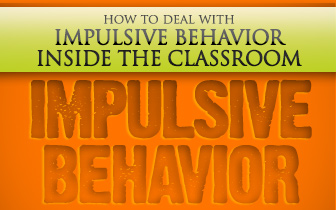Impulsive behavior of students can be a great problem for any teacher. It distracts the whole class, disrupts lectures, and can be a hindrance to the learning process.
Teachers must be able to understand the nature of impulsivity in children in order to manage classroom situations properly.

The Nature of Impulsive Behavior
Children are naturally impulsive. Their cognitive abilities are still developing, so they cannot effectively control their impulses yet. They are not yet able to plan their actions and decide rationally. Because their view of the world is still centered on the self, they are usually not aware of the consequences of their impulsivity. They sometimes have no idea that it can affect other people in a negative way.
Impulsivity in young children can be a problem in the classroom. A child exhibiting impulsive behaviors class is a distraction to his classmates and to the teacher. Shouting, singing, not paying attention to the lesson, not cooperating in activities, fighting with classmates - these are some examples of what an impulsive student may do.
Impulsivity in children lessens as they grow older. But in special cases, impulsive behaviors do not go away, as in the cases of children with Attention-deficit/hyperactivity disorder or ADHD. In either case, a teacher can successfully manage an impulsive student in the classroom by keeping in mind that it is not always a deliberate act on the part of the student.

Ways to Manage Impulsive Behavior in Students
As a teacher, you first have to identify which students are prone to impulsivity. You are responsible for monitoring their behavior and intervening immediately when it occurs. Here are some ways in which you can manage the classroom when there are students who exhibit impulsive behavior. See what works for the child, and remember that what works for one may not work for another.
-
1
When correcting the student for impulsive behavior, stress that you are reprimanding the action, and not the person. By separating the impulsive action from his whole self, the student will not associate impulsivity with his character, making it easier to abandon the behavior.
-
2
Do not instill on the student that he is a bad student because of his impulsive behavior. Negative treatment will only make it worse. The student has to see it in you that you are looking forward to a positive change in behavior.
-
3
Appeal to the student’s empathy and make it known that others can get hurt as a consequence of the impulsive actions.
-
4
Make the student understand what actions are expected of him in and outside of the classroom. The child may not have a clear picture of what exactly proper behaviors are.
-
5
Believe in positive reinforcement! Reward the student if he exhibits good behavior and succeeds in controlling his impulses.
-
6
Eliminate sources of stimulation or distraction in the classroom to curtail impulsive behavior. Toys, gadgets, etc., must be kept away during class hours.
-
7
Instill a sense of responsibility on the student by assigning various tasks in the classroom. For example, appointing a student who usually misbehaves to be a leader in a certain activity may evoke a sense of duty. It will also channel a child’s energy into more productive tasks.
-
8
Include in your discussions subtle reminders about impulse control and deliberate action. Children also learn by example, so be a role model for good behavior in class.
-
9
Put visual reminders on how to resist impulsive behavior inside the classroom.
-
q
Make an effort to communicate with the student’s parents. Sometimes there are problems at home which can cause the student to exhibit negative behaviors in school. Make sure you give a clear description of the child’s behavior to the parents.
-
w
Do not shy away from using the internet as a source of guidance. There are many competent websites, like thefamilycrompass.com, that can help you manage your students. Professional advice is just a click away.
No child is ever a lost cause. With patience, understanding, and genuine concern, you can help your student channel energy into more positive behaviors.
I believe that with the right information and great tips from the professionals, you can effectively manage students’ impulsive behaviors in the classroom.
P.S. If you enjoyed this article, please help spread it by clicking one of those sharing buttons below. And if you are interested in more, you should follow our Facebook page where we share more about creative, non-boring ways to teach English.







